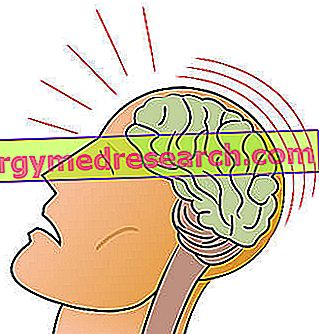What is the Angioedema?
Angioedema is an inflammatory reaction of the skin, similar to urticaria, characterized by the sudden appearance of an area of swelling of the skin, mucosa and submucosal tissues. Angioedema symptoms can affect any part of the body, but the most commonly affected areas are eyes, lips, tongue, throat, genitals, hands and feet.

In most cases, the reaction is harmless and leaves no lasting signs, even without treatment. The only danger is the possible involvement of the throat or tongue, since a severe swelling of them can cause rapid pharyngeal obstruction, dyspnea and loss of consciousness.
Difference with the Urticaria
Angioedema and urticaria are the result of the same pathological process, so they are similar in several aspects:
- Often, both clinical manifestations coexist and overlap: urticaria is accompanied by angioedema in 40-85% of cases, while angioedema can occur without hives only in 10% of cases.
- Urticaria is less severe, as it affects only the superficial layers of the skin. Angioedema, on the other hand, involves deep subcutaneous tissues.
- Urticaria is characterized by the temporary onset of an erythematous and itchy reaction in well-defined areas of the dermis (the appearance of wheals that are more or less red and raised). In angioedema the skin instead retains a normal appearance, remaining devoid of wheals. Furthermore, it can occur without itching.
The main differences between urticaria and angioedema are shown in the following table:
| Feature | Angioedema | Urticaria |
| Fabrics involved | Hypoderm (subcutaneous layer) and submucosal (under the dermis) | Epidermis (outer layer of skin) and dermis (inner layer of skin) |
| Affected organs | Skin and mucous membranes, in particular eyelids, lips and oropharynx | Only the skin |
| Duration | Transient (24-96 hours) | Transient (usually <24 hours) |
| Physical signs | Edema (swelling) under the surface of the skin | Erythematous and whitish patches on the surface of the skin. |
| Symptoms | The itching may or may not be present. Angioedema is often accompanied by pain and swelling. | The rash associated with urticaria is generally itchy. Pain and swelling are not common symptoms. |
Causes
Depending on the causes of origin, angioedema can be classified in different forms: acute allergic, drug-induced (non-allergic), idiopathic, hereditary and acquired.
| Type of angioedema and clinical features | Causes |
Allergic angioedema The swelling is caused by an acute allergic reaction, almost always associated with urticaria, which occurs within 1-2 hours of exposure to the allergen. Sometimes, it is accompanied by anaphylaxis. The reactions are self-limiting and subside within 1-3 days, but may arise again in the case of repeated exposures or due to interaction with cross-reactive substances. |
|
Non-allergic drug-induced reaction Some medications can cause angioedema as a side effect. Onset may occur days or months after the first intake of the drug, due to a cascade of effects that induce the activation of the quinine-kallikrein system, the metabolism of arachidonic acid and the generation of nitric oxide. |
|
Idiopathic angioedema In some cases, there is no known cause of angioedema, although some factors can trigger the symptoms. The idiopathic form is often chronic and recurrent and usually occurs together with urticaria. In some people, where the condition occurs for years without an obvious cause, an autoimmune process may exist at the base. |
|
Hereditary angioedema Autosomal dominant inherited disease. Hereditary angioedema is characterized by low levels of a serine protease inhibitor (C1 or C1-INH inhibitor), which helps keep blood vessels stable and regulates the escape of fluid into tissues. The decreased activity of the C1 inhibitor leads to an excess of kallikrein, which, in turn, produces bradykinin, a powerful vasodilator. |
|
| Acquired angioedema Acquired deficiency of the C1 inhibitor |
|
Whatever the cause of angioedema, the underlying pathological process is the same in all cases: the swelling is the result of the loss of fluid from the walls of the small blood vessels that supply the subcutaneous tissues.
In the skin, histamine and other inflammatory chemical mediators are released, leading to redness, itching and swelling. Mast cells of the dermis or mucosa are involved in different events. Mast cell degranulation releases vasoactive primary mediators such as histamine, bradykinin and other quinines; subsequently, secondary mediators are released, such as leukotrienes and prostaglandins, which contribute to inflammatory responses both early, and late, with increased vascular permeability and leakage of fluid into superficial tissues. The triggering factors and the mechanisms involved in the release of these inflammatory mediators allow the different types of angioedema to be defined.
Symptoms
The clinical signs of angioedema may vary slightly between the different forms, but in general the following manifestations appear:
- Localized swelling, usually involving periorbital area, lips, tongue, oropharynx and genitals;
- The skin may appear normal, ie without hives or other rashes;
- Pain, heat, itching, tingling or burning in the affected areas;
Other symptoms may include:
- Abdominal pain caused by swelling of the mucosa of the gastrointestinal tract, with nausea, vomiting, cramps and diarrhea;
- Swelling of the bladder or urethra, which can cause urination difficulties;
- In severe cases, swelling of the throat and / or tongue can make breathing and swallowing difficult.
Diagnosis
Diagnosing angioedema is relatively simple. Due to its distinctive appearance, a doctor should be able to recognize it after a simple physical examination and a detailed medical history.
Additional tests, such as blood tests, may be needed to define exactly the type of angioedema. The prick test can be performed to identify any allergens (allergic angioedema). Hereditary angioedema can be diagnosed with a blood test to check the level of proteins regulated by the C1-INH gene: a very low level confirms the disease. Diagnosis and management of hereditary angioedema are highly specialized and must be performed by a clinical immunology specialist. Angioedema can be associated with other medical problems, such as iron deficiency, liver disease and problems with the thyroid, which doctors will investigate with simple blood tests (useful for verifying or excluding the presence of these conditions). Idiopathic angioedema is usually confirmed by a process known as "exclusion diagnosis"; in practice the diagnosis is confirmed only after the various investigations have excluded any other disease or condition from similar manifestations.
Treatment
The treatment of angioedema depends on the severity of the condition. In cases where the respiratory tract is involved, the first priority is to ensure that the airways are open. Patients may need emergency hospital treatment and need intubation.
In many cases, the swelling is self-limiting and resolves spontaneously after a few hours or days. Meanwhile, to alleviate the milder symptoms you can try to put these measures into practice:
- Eliminate specific triggering stimuli;
- Take a cold shower (but not too much) or apply a cold pack on the affected area;
- Wear loose clothing;
- Avoid rubbing or scratching the affected area;
- Take an antihistamine to relieve itching.
In severe cases, if the swelling, itching or pain is persistent, the following medications may be indicated:
- Oral or intravenous corticosteroids;
- Antihistamines by mouth or by injection;
- Adrenaline injections (epinephrine).
The goal of treatment for angioedema is to reduce symptoms to a tolerable level and able to guarantee normal activities (for example, work or night rest).
Angioedema associated with chronic autoimmune or idiopathic urticaria is often difficult to treat and the response to drugs is variable. Generally, the following treatment steps are recommended, where each step is added to the previous one, if it does not produce an inadequate response:
- Step 1: non-sedative antihistamines, for example cetirizine;
- Step 2: sedative antihistamines, for example, diphenhydramine;
- Step 3:
- a) oral corticosteroids, for example, prednisone;
- b) immunosuppressants, for example cyclosporin and methotrexate.



